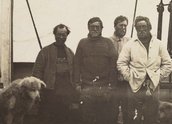
My South Polar Expedition (1910)
Synopsis
Sir Ernest Shackleton and four men, with four Manchurian ponies, attempted to be the first to reach the South Pole in 1908. In this recording, he tells how the loss of the last pony almost killed one of the men and made the journey much more arduous.
Curator’s notes
We know very little about this recording, but a great deal more about the events that Sir Ernest Shackleton was describing. Shackleton himself gives us the date on which it was made – 30 March – and the year is thought to have been 1910. The recording was done in Britain on an Edison Phonogragh, probably as a commercial recording, for sale to the small but growing numbers who owned the Edison machine. Shackleton appears to be reading the text, which suggests it comes partly from his book about the Nimrod expedition, published to great acclaim and in several countries, in late 1909.
Shackleton had reached England in June 1909, to great public acclaim and considerable private controversy. His claim to have reached further south toward the Pole than any previous expedition was doubted by some of his rivals, including Robert Falcon Scott, whose record he broke. So the book – The Heart of the Antarctic, published in November – was to some extent an act of self-defence and rebuttal, as well as an attempt to reap the highest possible monetary rewards. Shackleton was heavily in debt after the expedition, and badly needed money. He could not even pay the members of the expedition. This recording may have been another aspect of his campaign to raise funds.
The story Shackleton recounts is about the loss of the pony named Socks, who fell into a crevasse on 7 December 1908. This was during Shackleton’s attempt, with three of his men, to be the first to reach the South Pole. The other men were Frank Wild, Eric Marshall and Jameson Adams. They took four Manchurian ponies to help them make the journey, which he estimated at 2,700 kilometres return, departing their base camp on 29 October 1908.
The decision to use ponies instead of dogs was controversial, because it was not known how well they would perform crossing broken ice and deep snow drifts. In fact, the ponies were a mistake, often slowing the party down. By 7 December, Socks was the only one left, the others having been shot and cut up for food. ‘Noble little Socks had found a resting place at last’, Marshall wrote in his diary. ‘He died in harness like a true soldier!’
For more on Shackleton’s Antarctic expeditions, see Endurance (1933).
- Overview
- Curator’s notes
- Audio full title
- Principal credits
- Find a copy
- Make a comment
- Extras
- Add your review



